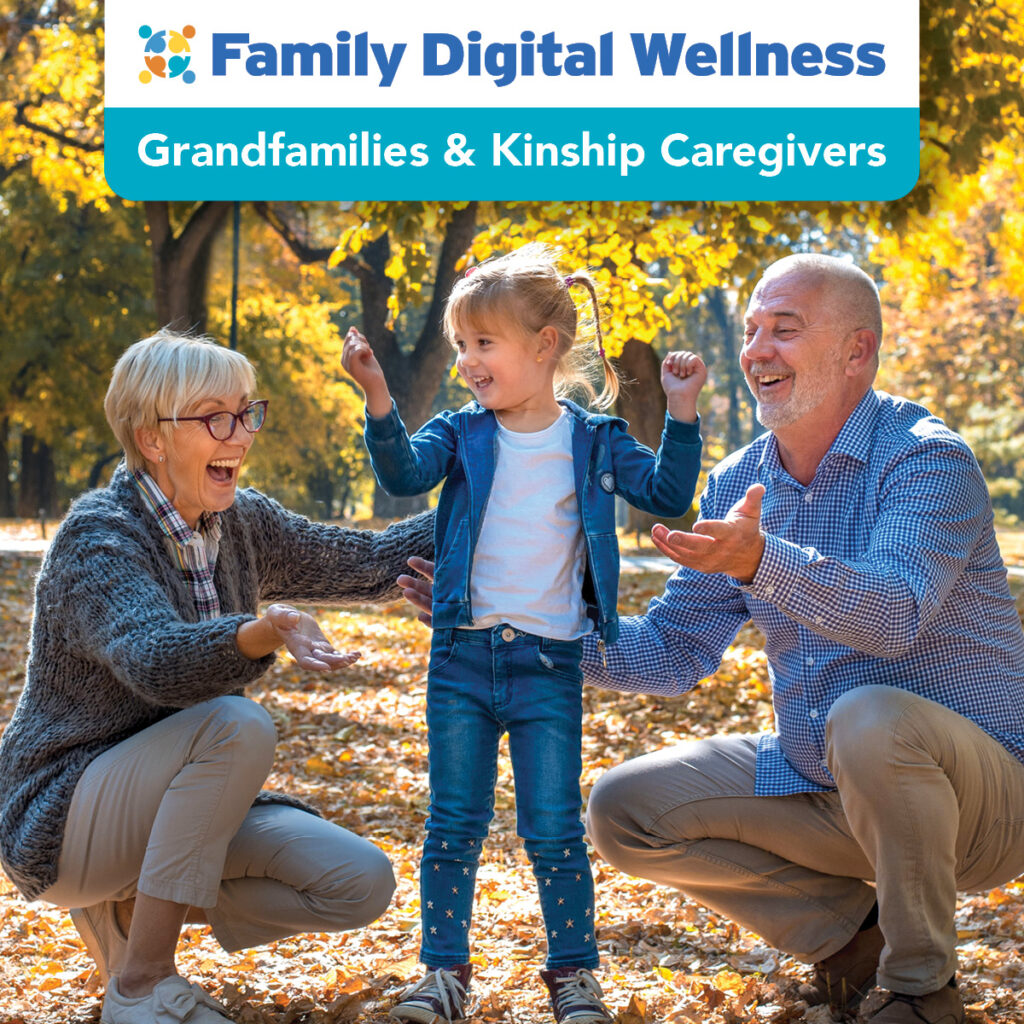Family Digital Wellness: A plan for grandfamilies & kinship caregivers

Many grandparents know how to handle meals, homework, and bedtime. Today, a newer challenge sits beside the cereal bowls — group texts, scrolling feeds, and AI chatbots that can talk at 2 a.m. For many multigenerational households, the hardest time isn’t bedtime — it’s screen time. That’s where Family Digital Wellness steps in to help. Family Digital Wellness is a simple, relationship-first way to keep the good of technology (schoolwork, connection with friends) while lowering the risks to sleep and mental health.
How screens and devices affect children
Digital tools can be helpful, but too much — especially late at night — can upset the basics kids need to thrive. Phones and notifications keep the brain on, so children fall asleep later and sleep less soundly. Less sleep often shows up as crankiness in the morning, trouble getting started on schoolwork, and more arguments at home. Social media can add pressure: unkind messages and constant comparing can raise worry and sadness, even in kids who seemed fine a week ago.
Attention can slip, too. When alerts interrupt homework, children bounce between tasks and remember less of what they study. AI chatbots bring their own challenges. They can feel like friendly companions, but they are not real friends; they sometimes repeat wrong information or echo a child’s negative thoughts back to them. None of this means you’ve failed or that technology must disappear. It’s only a sign that kids need clear routines and steady adults to guide how and when screens are used.
What prevention looks like
Prevention is less about perfect settings and more about predictable habits. Try these healthy digital habits:
- Values before rules. Name what your family protects — sleep, kindness, privacy, focus — and point every tech rule back to those values.
- Zones, not battles. Devices charge outside bedrooms; a “digital sunset” one hour before sleep; screens off during meals and rides.
- Co-learn weekly (10–15 minutes). Ask kids to teach you one feature or game; curiosity reduces secrecy and keeps conversations open.
- Say the AI rules out loud. Chatbots are tools, not friends; no private info; double-check claims; close the app and tell an adult if it feels creepy, pushy, or sad.
- Guard mental health. Watch mood after scrolling; swap doomscrolling for short “do-something” breaks; unfollow feeds that trigger worry or body-image stress.
- Make safety automatic. App-store approvals, age-appropriate filters, friend-only DMs/comments, and a posted list of trusted adults.
- Practice screenshot-and-tell. If content is mean, sexual, or scary, teach kids to not reply, screenshot the content and share it with a trusted adult.
- Review, don’t react. Hold a brief Sunday “tech check-in”: what helped, what hurt, one small change for the week.
Practical help for caregivers
Ask a librarian, senior center staffer, or phone-store employee to walk through settings with you right on your device. Post a Family Tech Card on the fridge (values, bedtime, charging spot, who to tell). Name two or three trusted adults — grandparent, aunt, school counselor — so a child knows exactly where to turn.
Other Family Digital Wellness resources
Want a printable plan, conversation starters, and step-by-step guidance? Learn more about Family Digital Wellness and find caregiver-friendly tools on our Family Digital Wellness hub. Empower your household with a plan you can revisit as kids grow and technology changes.
+++
NEWSLETTER BLURB:
Family Digital Wellness: A plan for grandfamilies & kinship caregivers
Group chats, scrolling feeds, and AI chatbots now sit beside the cereal bowls — and many caregivers say the hardest time isn’t bedtime, it’s screen time. While technology can help with homework and connection, heavy social media use and late-night device time are linked with sleep loss, anxious mood, and attention struggles. AI chatbots add new risks by echoing worries and sharing confident misinformation.
SO, WHAT CAN YOU DO? You don’t need a tech degree to make a difference. A simple Family Digital Wellness plan can steady routines and protect mental health without banning tech.
Visit our latest blog to learn plain-language AI rules, a printable plan you can post on the fridge, and practical steps any grandfamily or kinship caregiver can use to keep kids safe, rested, and connected.
Leave a Reply
You must be logged in to post a comment.